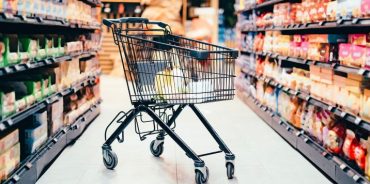As categories evolve and customer needs continue to change, how do retailers keep up?
Supermarkets have changed. While the overall format has remained the same for decades, subtle shifts have also begun to alter the way that we browse and buy. More than anywhere else, that can be seen in the sheer volume and variety of products on offer.
Just a few decades ago, the average store carried around 7,000 different items[1]. In an interview with Michel-Édouard Leclerc published just last year, he estimated that his banner carries anywhere between 30,000 to 50,000 individual products[2]. Obviously, this isn’t just a case of retailers squeezing more products on to their shelves. Instead, that huge increase relates mainly to a dramatic – and ongoing – evolution within individual categories.
The dairy category provides a perfect example of this in practice. Not too long ago, customers browsing those aisles would have been presented with a fairly simple set of choices when it came to something like milk. Beyond the core issues of price and brand, the selection process would largely be limited to whether a shopper wanted full-fat, semi-skimmed, or skimmed.
That’s no longer the case. Someone shopping for milk today faces an abundance of choice, particularly in the area of alternatives. Even a smaller retailer can offer everything from soya and almond milk through to specific flavours, formulations, and nutritional varieties like lactose free and high protein. What was once a simple decision is now a nuanced and, in many ways, deeply personal choice.
While dairy serves as a strong example of category evolution, it is far from the only one. Similar developments can be found everywhere from the bakery aisle, where bread and other products continue to diversify, through to soft drinks. Enhanced water, for instance, was largely non-existent just a few years ago. Now, it accounts for a not insignificant share of the category and is projected to grow from $6.79bn in 2021 to more than $10bn by 2027.
Sometimes, the introduction of new products such as these can affect multiple categories at once.
Take hard seltzer, for example, a drink that began taking the North America grocery market by storm around 2018. Before that product became as popular as it is today, shoppers would buy vodka (or other spirits) and soda to mix at home. Hard seltzer’s emergence into the zeitgeist, however, affected both the alcohol and soft drinks categories at once, attracting a raft of new customers – particularly younger shoppers and those with an interest in “healthier” (or, at least, lower-calorie) alcoholic beverages.
Naturally, that kind of trend is one that most retailers would like to be able to spot in advance.
One of the other major factors at play here is the significant rise in consumer expectations around personalisation. What began online has now become an all-pervasive part of shopping as a whole, with customers now wanting personalised experiences in both the physical and digital worlds.
Continuing category evolution serves to strengthen those perceptions; the more a category evolves, and the more specific products that are available, the more likely it is that customers will expect those goods to be available – no matter where they shop. That makes things complex from a format perspective, with retailers needing to think about how to deliver a superstore-like experience at convenience store level.
The presence of large online retailers only exacerbates this issue. When shoppers can’t get exactly what they want from a physical store, the likes of Amazon, La Belle Vie, and Cajoo provide them with the option of having even the most specific of grocery products delivered direct to their door in 24 hours or less.
So, how exactly do traditional grocery retailers respond to this challenge? Online, this is a (somewhat) easier thing to address. Just so long as you have the right, localised delivery capabilities in place, you can offer a range that’s as rich and varied as you – and your customers – like.
In store, that task is made much harder, because you need to have a very accurate picture of what individual customers within each catchment want. And, as categories continue to evolve, the situation becomes increasingly complex; physical stores don’t tend to get any bigger, but the number of products that customers might want is continually growing.
Fundamentally, the answers here revolve around the need to build individual planograms on a store-by-store basis. This is a complex endeavour, though, since doing so relies on both a deep understanding of individual preferences and the ability to spot emerging trends such as the hard seltzer example mentioned above.
Because of that, managing category evolution successfully means that retailers now require deep insight into the things that matter most to their customers, and there are two reasons for that:
- A richer understanding of customer preferences ensures that you can continue to offer the right products as their needs change, and;
- That insight can also help you to refine your range, particularly in terms of removing or cutting back on products that are no longer selling as well as they used to. The same is true when it comes to limiting your investment on lines that may prove to be short term fads.
dunnhumby Assortment provides retailers with insight into key products, not just in terms of those that need to be on the shelf, but also which items can be delisted based on factors like overlap, substitutability, and poor performance. Using real-world data from customers – including their shopping behaviours and basket contents – Assortment offers crucial guidance on which products should and shouldn’t be on the shelf and why.
Evidence of Assortment’s effectiveness can be seen in our work on a major category reset for one South African retailer. We found that the retailer’s range had grown to the extent that, rather than providing customers with a useful selection, it instead contained numerous duplicates and an excessive number of variants.
Using Assortment in tandem with another analytical tool by the name of dunnhumby Shop, we were able to see that 27% of the retailer’s products could safely be delisted. In doing so, the retailer was able to reduce its stock holding costs by 6% while simultaneously creating a better and more streamlined experience for its customers.
Not only does this kind of insights-driven approach to category evolution give you the ability to be smarter about managing customer needs, it also gives you the chance to lean in to emerging opportunities more easily. Exclusive innovation, where retailers partner with brands to release limited run products solely in their stores, can meet highly specific needs and enable them to own the moment around certain trends.
Category evolution is a continual process, of course, which means that your insights – and the critical customer and loyalty datapoints that power them – also need to be continually updated, something that we can attest to in our work for clients around the world.
At the same time, managing that evolution successfully is no mere defensive measure; done right, it can also be a platform for growth for those retailers (and consumer packaged goods brands) that want to lead the market as it continues to evolve, an “always on”, data-driven approach to category evolution is now imperative.
[1] Grocery stores carry 40,000 more items than they did in the 1990s – Market Watch, 17th June 2017
[2] Entretien. Michel-Édouard Leclerc : "Notre rôle, c'est de faire barrage à la spéculation et à un mur d'inflation" – La Dépêche, 8th June 2022
TOPICS
RELATED PRODUCTS
Create optimal ranges with retailers to achieve your assortment goals
Assortment Optimisation & Planning solutionsThe latest insights from our experts around the world




